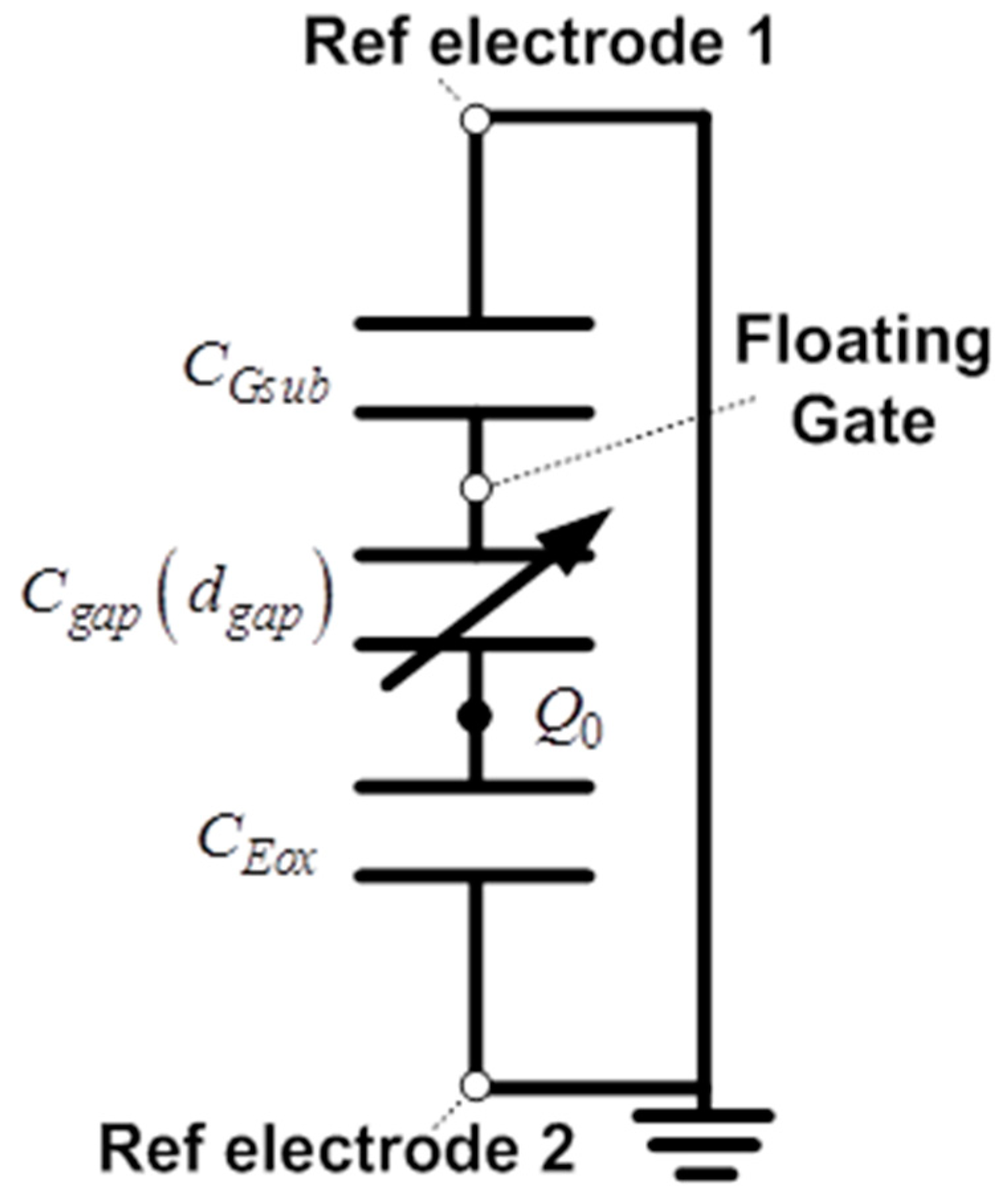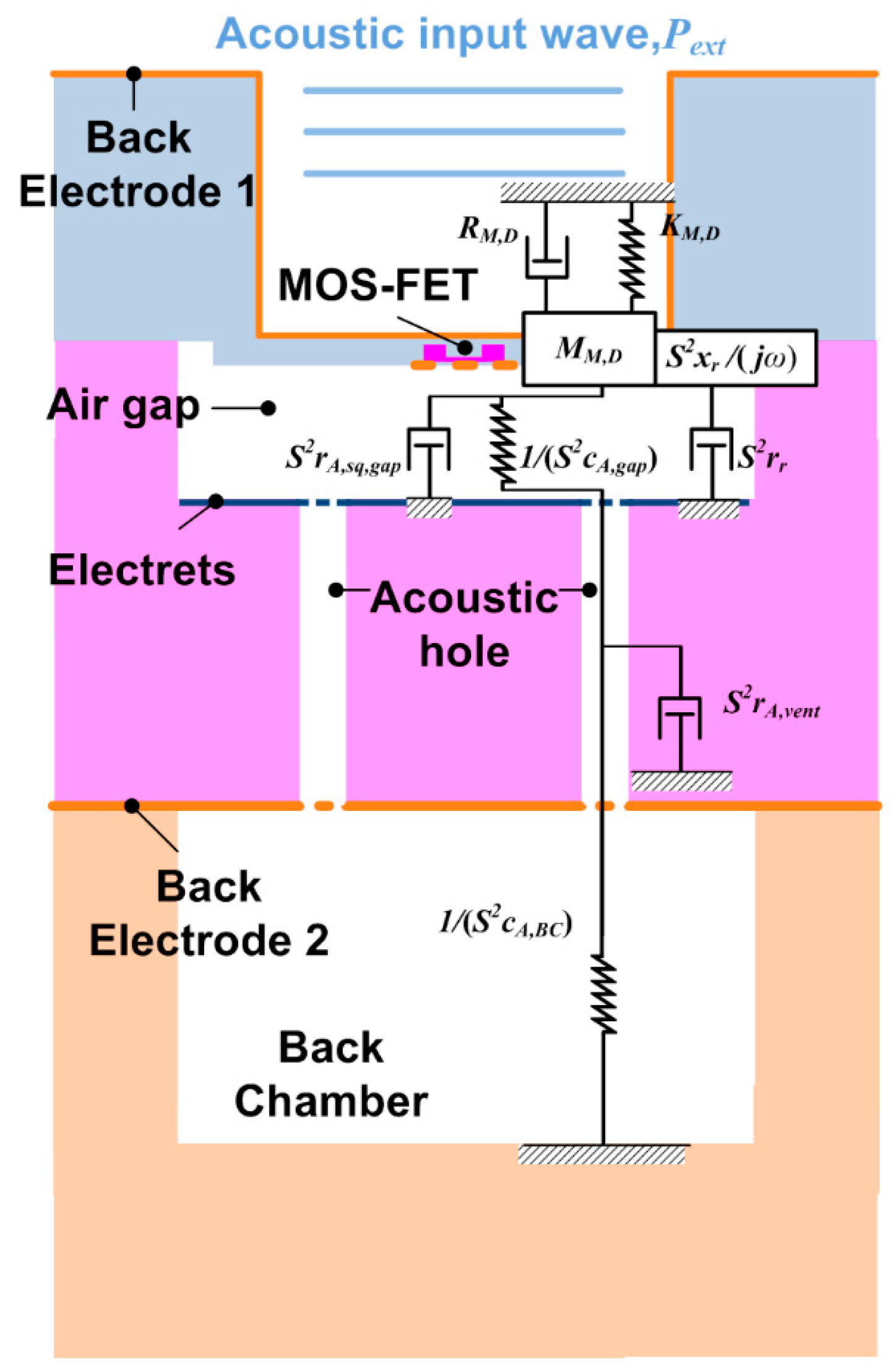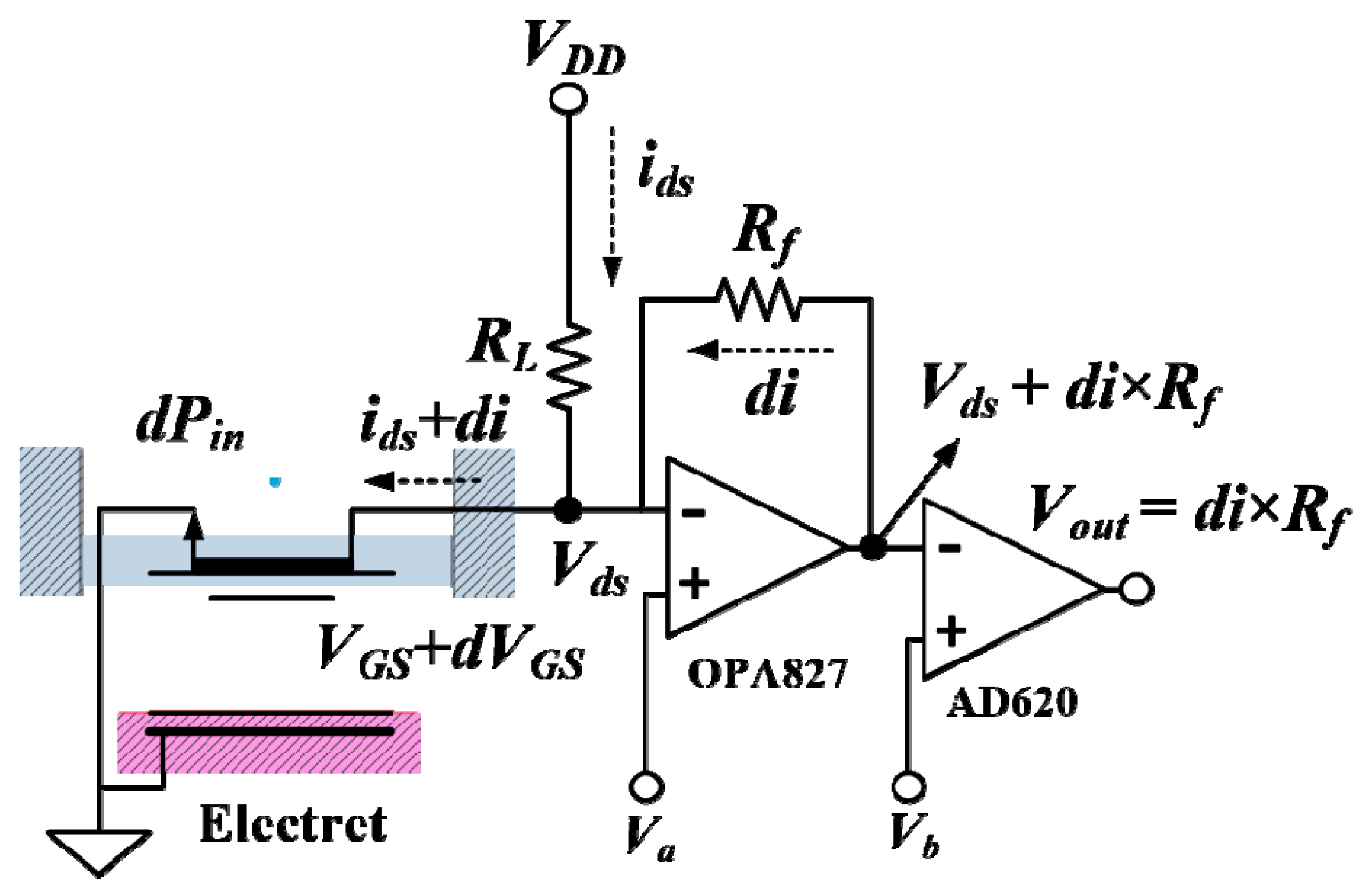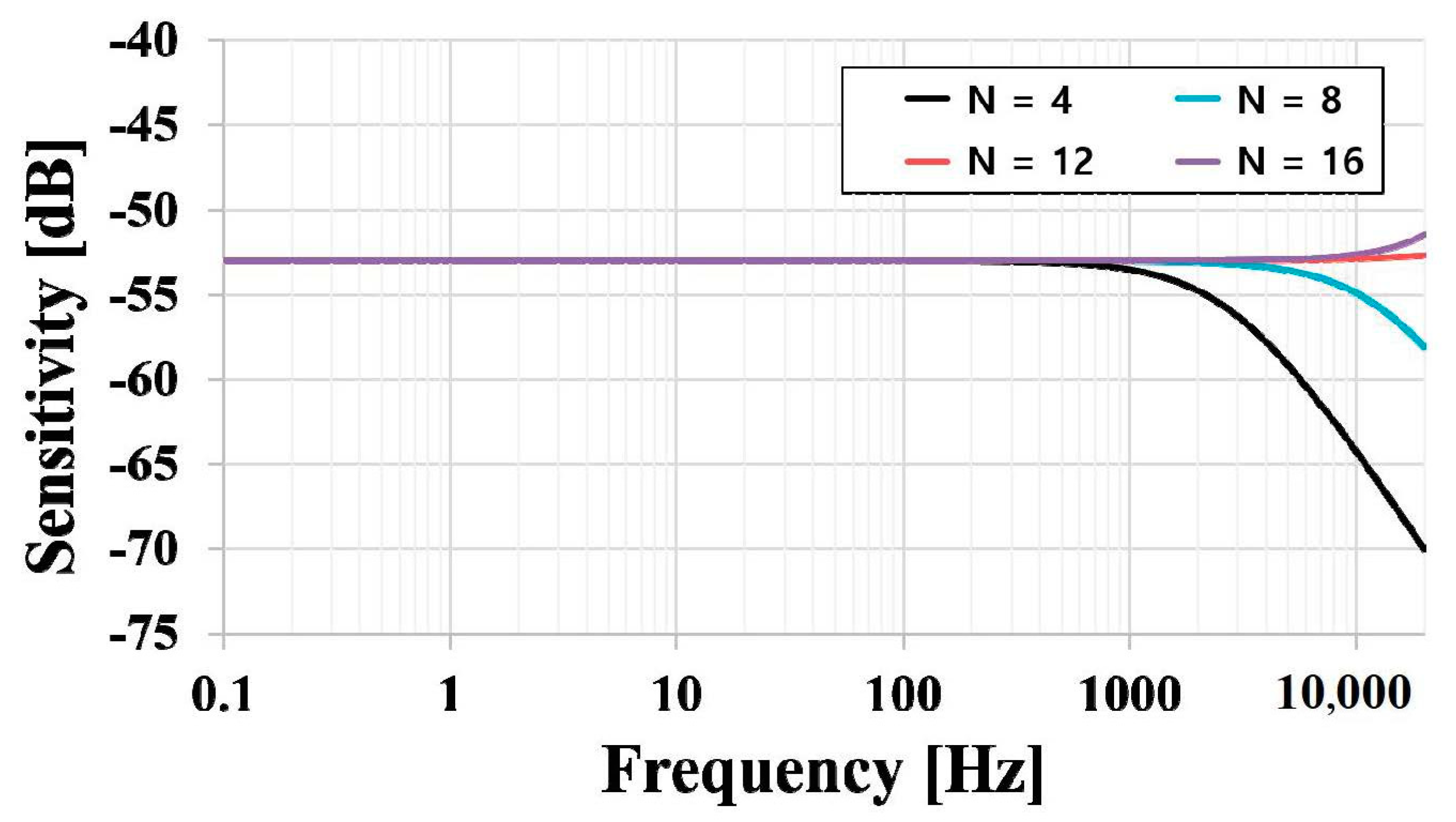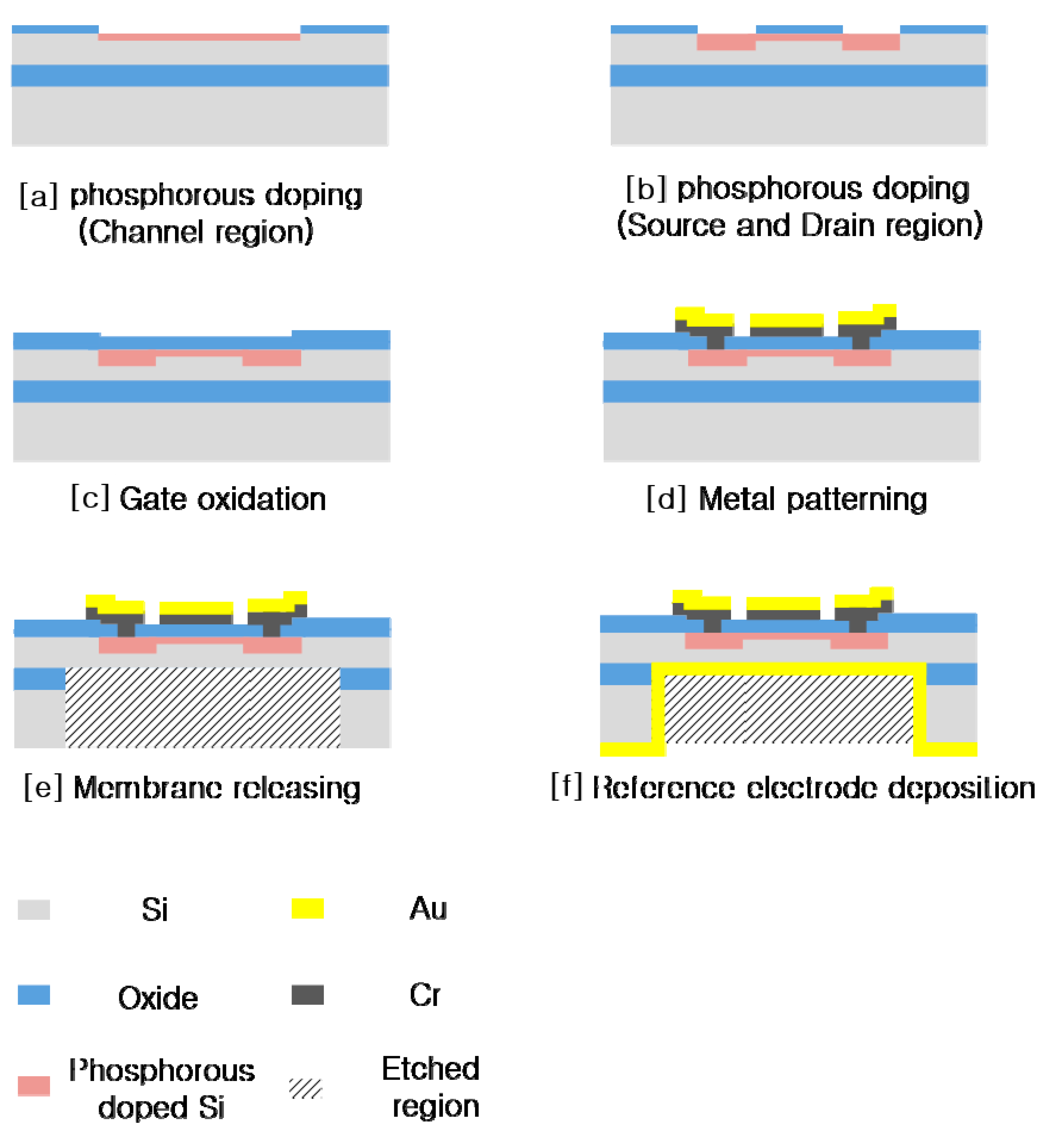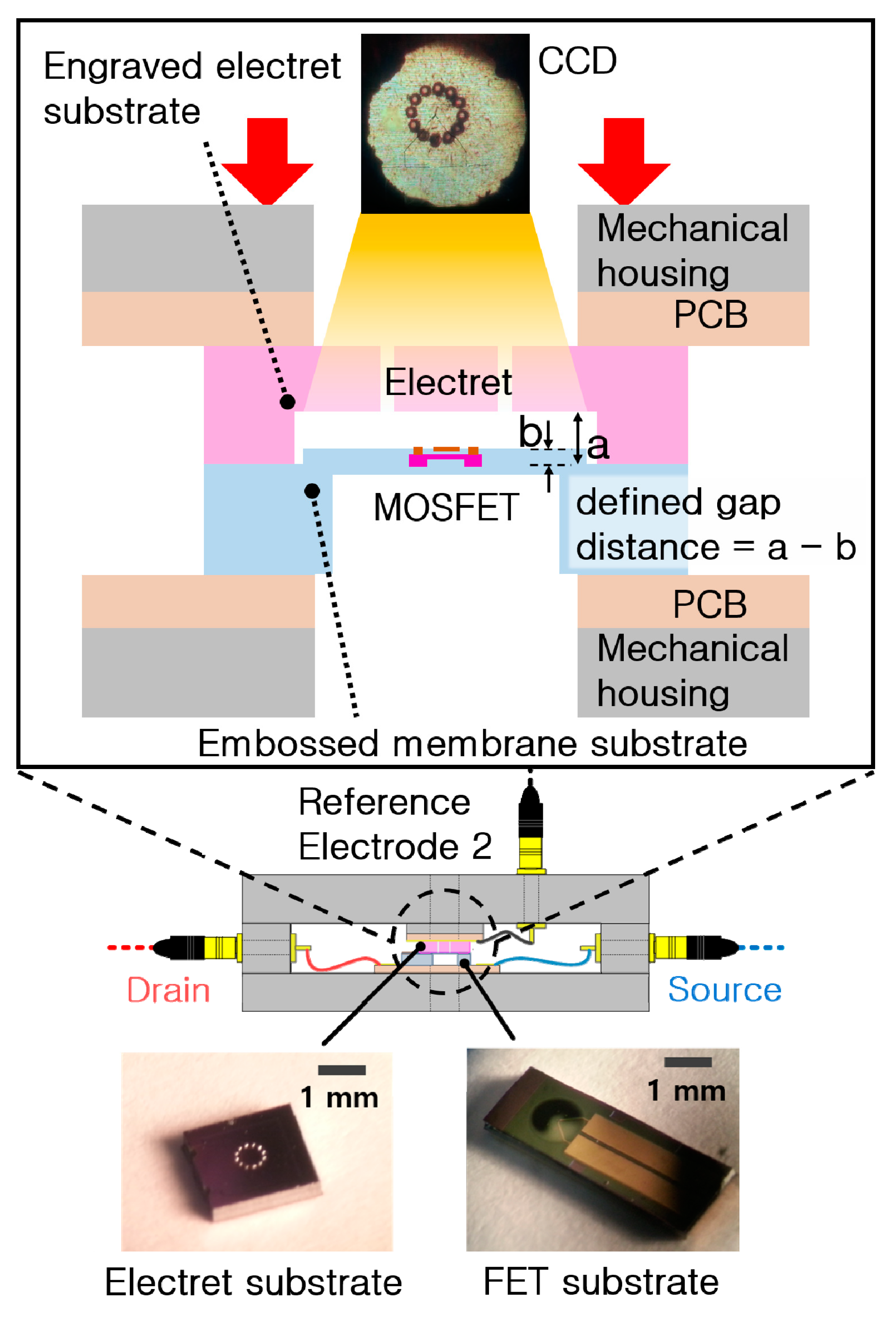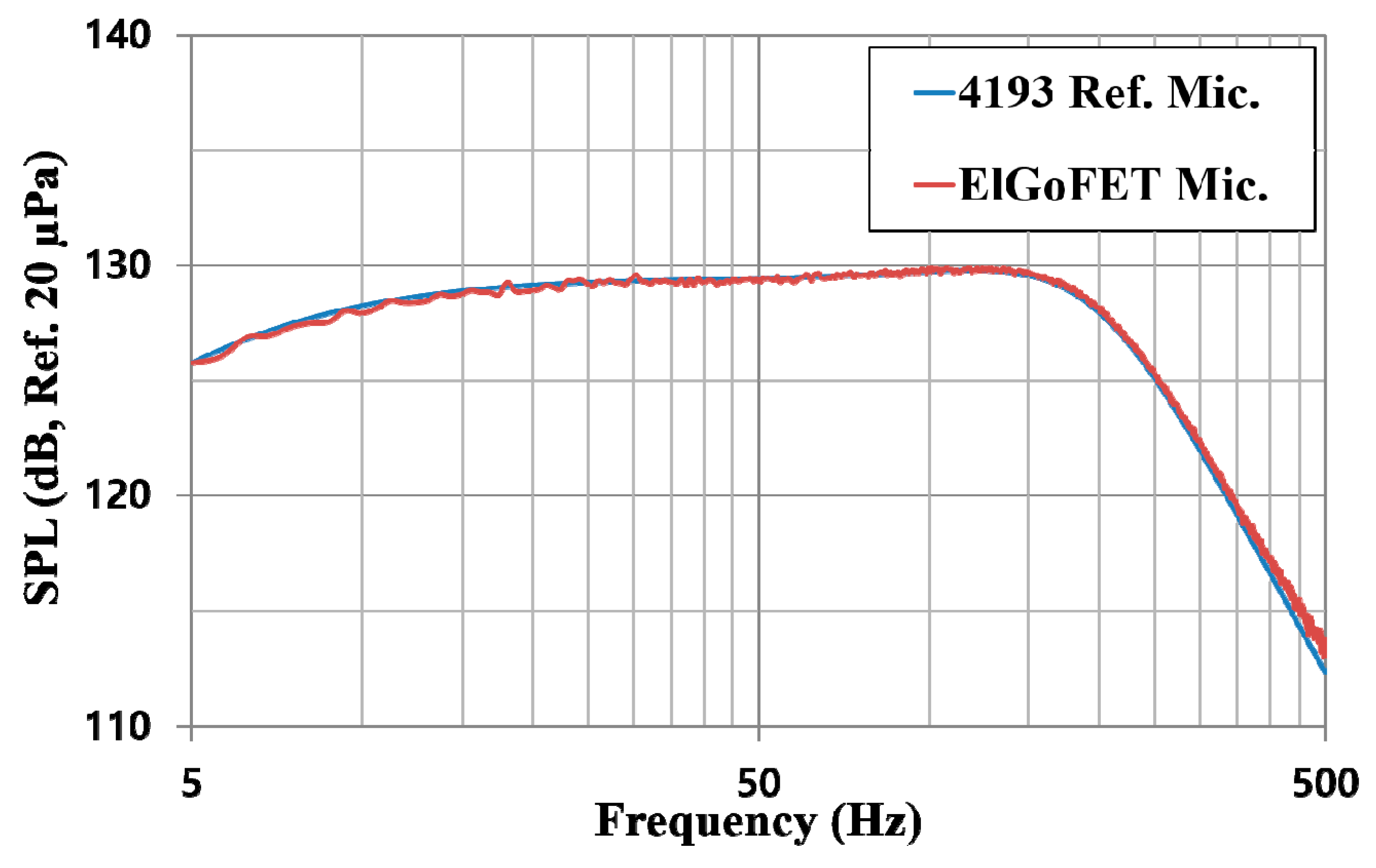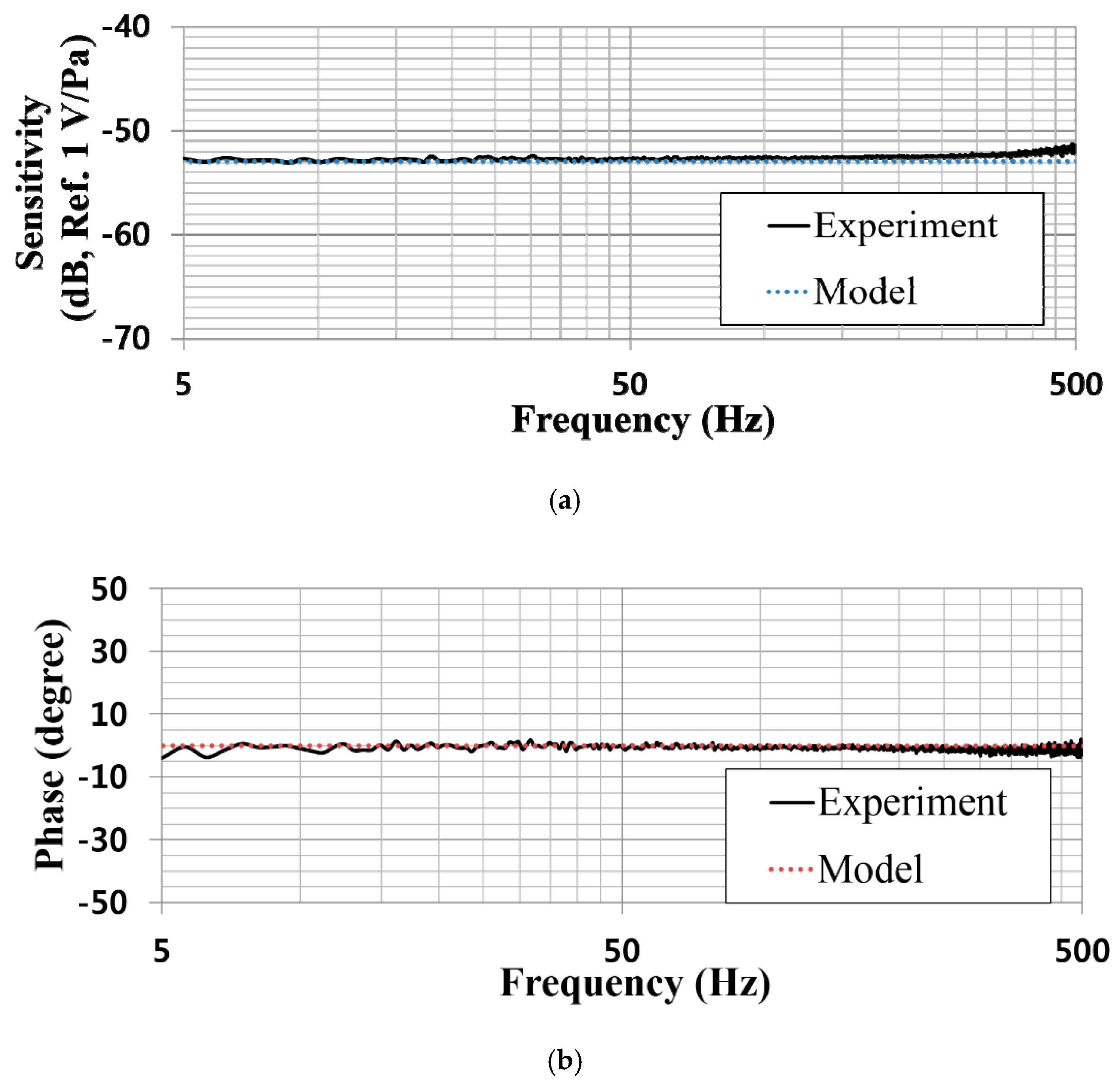2.1. Electromechanical Transduction of the ElGoFET Microphone
Figure 1 shows the structure of the ElGoFET microphone, which consists of a dielectric layer with semi-permanently fixed charges, a diaphragm with an FET mounted in the center, and an air gap between the dielectric layer and diaphragm. A charge-trapped dielectric layer, known as the electret, is used for applying the electric field to the gate electrode. Thus, when the diaphragm vibrates in response to external sound pressure
Pi, the distance
dgap between the diaphragm and electret changes. Because electric field intensity applied to the FET gate changes when
dgap changes, the electrical potential on the floating gate electrode of the FET,
VF.G also changes, which eventually affects the source−drain current
id.
Figure 2 shows the electrical equivalent circuit model of the ElGoFET transduction mechanism with three capacitors, to help explain the FET gate electric potential changes induced by the electric field intensity fluctuation.
CGsub,
Cgap, and
CEox represent the capacitors between the floating gate electrode and the reference electrode of the FET (reference electrode 1), the electret and the floating gate electrode, and the electret and the reference electrode of the electret (reference electrode 2), respectively. Trapped charges in the electret layer are expressed in the equivalent model as a fixed charge
Q0 between
Cgap and
CEox. Note that
Cgap is a function of
dgap, which means that the gap capacitance is dependent on the distance between the diaphragm and floating gate electrode, as
Cgap(
dgap).
CGsub and
CEox are constants set according to design parameters. Connecting the two reference electrodes to the ground, as shown in
Figure 2,
VF.G can be obtained using Equation (1), which is derived from the equivalent capacitor model considering the effects of the fixed charge
Q0 [
15]. This equation shows that the floating gate potential is a function of gap distance,
dgap, as follows:
In addition, the source−drain current
id follows the current (
I)–voltage (
V) square law [
16], which is a general characteristic of an FET
where
µ is the channel mobility,
C′ox is the gate oxide capacitance per unit area,
W and
L are the width and length of the gate, respectively, and
Vt is the threshold voltage of the FET. Since
VF.G is a function of
Cgap(
dgap), as in Equation (1), and the output current signal
id is a function of
VF.G, as shown in Equation (2), the ElGoFET transduction mechanism can directly measure displacement through the output current
id even under static conditions, where
dgap is almost unchanged [
15].
Based on this model, the electromechanical transduction sensitivity of the ElGoFET structure,
did/
ddgap, was obtained. The electromechanical sensitivity of the ElGoFET transduction mechanism means that changes in the source–drain current depend on changes in the gap. Therefore, the sensitivity can be defined as the product of
dVF.G/ddgap and
did/
dVF.G by the chain rule. The floating gate potential depends on the gap variance (
dVF.G/
ddgap), which can be obtained by differentiating Equation (1) with respect to
dgap, as follows:
In addition,
did/
dVF.G can be derived from Equation (2), which physically denotes the transconductance of the FET,
gm, as follows:
Therefore, the electromechanical transduction sensitivity
did/
ddgap can be expressed as the product of Equations (3) and (4):
From Equation (5), sensitivity is not determined only by one capacitance value, but instead by the ratio of capacitance (e.g., Cgap/CEox, Cgap/CGsub), which is a dimensionless parameter. This is an interesting aspect of the mechanism. For a conventional MEMS microphone, sensitivity is strongly dependent on the gap capacitance, and therefore on the design trade-off between the sensitivity and cut-off frequency with miniaturization. However, because the sensitivity of ElGoFET transduction is determined by the ratio of capacitance, it is possible to realize high sensitivity even with miniaturization. Although the absolute capacitance value of the sensing capacitance Cgap is decreased due to miniaturization, high sensitivity can be achieved by changing the capacitance ratio. Therefore, the problems resulting from miniaturization can be resolved using ElGoFET transduction.
2.2. Mechanoacoustical Transduction of the ElGoFET Microphone
The electromechanical mechanism of ElGoFET transduction was described earlier. Here, we describe the acoustic sensitivity model developed for applying ElGoFET transduction to a microphone. The current sensitivity of an ElGoFET microphone can be defined as the change in source–drain current with respect to input pressure,
did/
dPi. This is the product of the electromechanical sensitivity
did/
ddgap and mechanoacoustical sensitivity
ddgap/
dPi, as expressed in Equation (6):
The mechanoacoustical sensitivity is the derivative of the displacement with respect to the input pressure,
ddgap/
dPi, and is determined by the diaphragm and acoustic structure of the sensor. In this study, the acoustic structure generally used in a MEMS microphone was adapted for the ElGoFET microphone, as shown in
Figure 3. Specifically, to reduce the sealed impedance of the air-gap, acoustic holes were created in the electret substrate to enable fluids in the air-gap to move to the back chamber. Because MEMS microphones are much smaller than the input pressure wavelength, the ElGoFET microphone was modeled using the one-degree-of-freedom lumped element model (LEM). The LEM shown in
Figure 3 incorporates two types of impedance components: mechanical (denoted with capital letters) and acoustic (represented with lowercase letters) impedance components.
The mechanical impedance of the diaphragm is defined as
where
KM,D,
MM,D, and
RM,D are the equivalent stiffness, equivalent mass, and mechanical damping coefficient of the diaphragm, respectively, given by
where
E is Young’s modulus,
t is the thickness of the diaphragm,
a is the radius of the diaphragm,
v is Poisson’s ratio, Λ
0 is the frequency constant,
ρm is the density of the diaphragm, and
QM is the mechanical quality factor. The acoustic radiation impedance is defined as
The radiation resistance
rr and radiation reactance
xr are defined below
where
S is the area of the diaphragm,
ρ0 is the density of the medium,
c is the sound velocity of the medium,
Ji(
x) is a first-order Bessel function,
H1(
x) is a Struve function, and
k is the wave number. The acoustic effects of air at the back side of the diaphragm can be analyzed in a similar way using an LEM. The acoustic characteristics of the thin-film air layer between the diaphragm and electret substrate are modeled based on the compliance
cA,gap caused by air compression and the squeeze film damping
rsq caused by fluid viscosity. These parameters can be expressed using the following equations [
17]
where
Vgap is the volume of the air gap,
µ is the viscosity coefficient of air, and
N is the number of acoustic holes.
G(
A) represent the effects of decreasing the squeeze film area due to the acoustic hole, and
A is the area ratio with respect to the diaphragm.
G(
A) can be expressed using Equation (16) [
11]:
The air fluid resistance coefficient through an acoustic hole is given by [
10,
11]
where
l and
r are the length and radius, respectively, of the acoustic hole. The acoustic hole is connected to a back chamber; the representative lumped element of the back chamber is a large air volume. Considering that the back-chamber volume is much larger than the air gap volume, compliance caused by the compression of air is the only component of acoustic impedance
where
VBC is the volume of the back chamber. The air gap, acoustic hole, and back chamber are connected to form an acoustic structure. The acoustic impedance of the structure on the back side of the diaphragm can be written as follows:
Considering all of the impedance components of the microphone, including the diaphragm and acoustic structure, the mechanoacoustical sensitivity is given by
where
Ztotal = Zm + Zr + Zb. Currently, the ElGoFET current sensitivity
did/dPi [
6] can be obtained from the product of the mechanoacoustical sensitivity (Equation (20)) and the electromechanical sensitivity (Equation (5)).
Figure 4 shows the
I–
V converter analog circuit that converts the output current signal from the ElGoFET to an output voltage signal. The feedback resistor,
Rf, determines the current-to-voltage transformation ratio. As such, the overall ElGoFET microphone sensitivity, which is defined as the change in output voltage signal with respect to the input sound pressure, is as follows:
2.3. Design of the ElGoFET Microphone
An ElGoFET microphone was designed based on the theoretical model derived above. As represented in Equation (21), the overall sensitivity of the ElGoFET microphone was determined by the ratios of capacitance
Cgap/
CEox and
Cgap/
CGsub.
Figure 5 shows the dependence of sensitivity on
Cgap/
CEox and
Cgap/
CGsub. The range of each capacitance ratio is expressed in Equations (22) and (23) as
The reference sensitivity level
MM is the mechanoacoustical sensitivity, 20log (
ddgap/
dPi). Therefore,
Figure 5 represents the dependence of electromechanical sensitivity on the ratio of capacitance with reference to
MM. The values of design parameters were determined considering both the theoretical calculation expressed in
Figure 5 and the fabrication limitations of the ElGoFET microphone. First, the thickness of the gate oxide was determined to be 30 nm considering the sensitivity of the FET and its electrical stability; its length and width were 2 and 8.5 μm, respectively. The transconductance of the FET,
gm, was designed to be 103 µA/V. Considering the focused ion beam (FIB) process for the electret [
18], the fixed charge
Q0 in the 500-nm-thick dielectric layer over a 1 × 1 mm
2 area for the electret substrate was determined to be 7.03 nC, which was measured using an electrostatic voltmeter (Trek 323; Trek Inc., Lockport, NY, USA). The gap distance between the FET-mounted diaphragm and electret substrate,
dgap, was determined to be 5 μm by considering the backing impedance effect and fabrication process. Therefore, the gap capacitance,
Cgap, was calculated as 1.08 fF using the commercial FEM software COMSOL Multiphysics (COMSOL, Inc., Burlington, MA, USA). The chosen capacitance ratio is expressed in Equations (24) and (25), and the sensitivity compared to the reference sensitivity level
MM is 22.3 dB (1 V/Pa), as shown in
Figure 5:
The diaphragm of the ElGoFET microphone was designed with a diameter and thickness of 1.2 mm and 5 μm, respectively, considering stable fabrication for an FET-embedded diaphragm. The first-order resonance frequency of the designed diaphragm was 49 kHz, which ensures a flat frequency bandwidth below 20 kHz. Based on the theoretical approach and design parameters, the frequency response of the ElGoFET microphone was simulated according to the acoustic hole design parameters over a frequency ranging from 0.1 Hz to 20 kHz, as shown in
Figure 6. The acoustic holes were 170 μm in diameter and 500 μm in length; the material properties used in the calculation are listed in
Table 1. The frequency response changed with the number of acoustic holes. Increasing the open area by increasing the number of acoustic holes reduced the thin-film damping effect, as described in Equation (15). For this reason, the number of acoustic holes was set at 12, and the simulated sensitivity was −53 dB. In the low-frequency region, the simulated response did not exhibit the low-frequency roll-off problems typical of MEMS microphones. There was no sensitivity decrease related to the number of acoustic holes in the low-frequency region; rather, a very flat frequency response was observed.
In the capacitive transduction mechanism used in general MEMS microphones, the velocity of the diaphragm in the low-frequency region is determined by the acoustic low cut-off frequency. The acoustic holes allow the air compressed in the air gap chamber to flow out into the back chamber; consequently, the diaphragm tends to move more easily under these conditions. The acoustic hole design affects the low-frequency performance of the microphone, because the resistance of the acoustic holes and compliance of the back chamber act as an acoustic low-frequency cut-off filter. Therefore, in the conventional MEMS microphone design, acoustic holes are key to reducing the roll-off problem [
6,
12,
13]. However, in displacement-based ElGoFET transduction, the frequency response in the low-frequency region was not strongly affected by hole resistance. Because the backing fluid resistance change related to the number of acoustic holes was negligible in terms of displacement, a flat frequency response in the low-frequency region was achieved, as shown in the simulation results. Therefore, these data provide theoretical evidence that the ElGoFET displacement sensitive transduction mechanism can effectively overcome the sensitivity degradation problem in the low-frequency region, which eventually results in a flat frequency response over a wide bandwidth, even with miniaturization.

